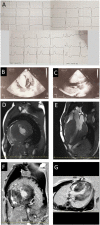Case Report: Two New Cases of Autosomal-Recessive Hypertrophic Cardiomyopathy Associated With TRIM63-Compound Heterozygous Variant
- PMID: 35273634
- PMCID: PMC8901572
- DOI: 10.3389/fgene.2022.743472
Case Report: Two New Cases of Autosomal-Recessive Hypertrophic Cardiomyopathy Associated With TRIM63-Compound Heterozygous Variant
Abstract
Hypertrophic cardiomyopathy (HCM) is one of the most common hereditary diseases, and it is associated with fatal complications. The clinical heterogeneity of HCM requires risk prediction models to identify patients at a high risk of adverse events. Most HCM cases are caused by mutations in genes encoding sarcomere proteins. However, HCM is associated with rare genetic variants with limited data about its clinical course and prognosis, and existing risk prediction models are not validated for such patients' cohorts. TRIM63 is one of the rare genes recently described as a cause of HCM with autosomal-recessive inheritance. Herein, we present two cases of HCM associated with TRIM63-compound heterozygous variants in young male sportsmen. They demonstrated progressively marked hypertrophy, advanced diastolic dysfunction, a significant degree of fibrosis detected by magnetic resonance imaging, and clear indications for implantable cardioverter-defibrillator. One of the cases includes the first description of TRIM63-HCM with extreme hypertrophy. The presented cases are discussed in light of molecular consequences that might underlie cardiac and muscle phenotype in patients with mutations of TRIM63, the master regulator of striated muscle mass.
Keywords: MuRF1; TRIM63; compound heterozygote; diastolic dysfunction; extreme hypertrophy; hypertrophic cardiomyopathy.
Copyright © 2022 Andreeva, Chumakova, Karelkina, Lebedeva, Lubimtseva, Semenov, Nikitin, Speshilov, Kozyreva, Sokolnikova, Zhuk, Fomicheva, Moiseeva and Kostareva.
Conflict of interest statement
The authors declare that the research was conducted in the absence of any commercial or financial relationships that could be construed as a potential conflict of interest.
Figures



Similar articles
-
Mutations in TRIM63 cause an autosomal-recessive form of hypertrophic cardiomyopathy.Heart. 2020 Sep;106(17):1342-1348. doi: 10.1136/heartjnl-2020-316913. Epub 2020 May 25. Heart. 2020. PMID: 32451364 Free PMC article.
-
Human molecular genetic and functional studies identify TRIM63, encoding Muscle RING Finger Protein 1, as a novel gene for human hypertrophic cardiomyopathy.Circ Res. 2012 Sep 14;111(7):907-19. doi: 10.1161/CIRCRESAHA.112.270207. Epub 2012 Jul 19. Circ Res. 2012. PMID: 22821932 Free PMC article.
-
Genes Associated With Hypertrophic Cardiomyopathy: A Reappraisal by the ClinGen Hereditary Cardiovascular Disease Gene Curation Expert Panel.J Am Coll Cardiol. 2025 Feb 25;85(7):727-740. doi: 10.1016/j.jacc.2024.12.010. J Am Coll Cardiol. 2025. PMID: 39971408 Free PMC article.
-
Hypertrophic Cardiomyopathy: Genetics, Pathogenesis, Clinical Manifestations, Diagnosis, and Therapy.Circ Res. 2017 Sep 15;121(7):749-770. doi: 10.1161/CIRCRESAHA.117.311059. Circ Res. 2017. PMID: 28912181 Free PMC article. Review.
-
Current perspectives in hypertrophic cardiomyopathy with the focus on patients in the Finnish population: a review.Ann Med. 2016 Nov;48(7):496-508. doi: 10.1080/07853890.2016.1187764. Epub 2016 Jul 27. Ann Med. 2016. PMID: 27460395 Review.
Cited by
-
Exploring the complex spectrum of dominance and recessiveness in genetic cardiomyopathies.Nat Cardiovasc Res. 2023;2(11):1078-1094. doi: 10.1038/s44161-023-00346-3. Epub 2023 Oct 9. Nat Cardiovasc Res. 2023. PMID: 38666070 Free PMC article.
-
HCM-Associated MuRF1 Variants Compromise Ubiquitylation and Are Predicted to Alter Protein Structure.Int J Mol Sci. 2025 Apr 21;26(8):3921. doi: 10.3390/ijms26083921. Int J Mol Sci. 2025. PMID: 40332812 Free PMC article.
-
Hypertrophic Cardiomyopathy in Underrepresented Populations: Clinical and Genetic Landscape Based on a Russian Single-Center Cohort Study.Genes (Basel). 2023 Nov 4;14(11):2042. doi: 10.3390/genes14112042. Genes (Basel). 2023. PMID: 38002985 Free PMC article.
-
Exome sequencing data reanalysis of 200 hypertrophic cardiomyopathy patients: the HYPERGEN French cohort 5 years after the initial analysis.Front Med (Lausanne). 2024 Oct 31;11:1480947. doi: 10.3389/fmed.2024.1480947. eCollection 2024. Front Med (Lausanne). 2024. PMID: 39554508 Free PMC article.
-
Advanced searching for hypertrophic cardiomyopathy heritability in real practice tomorrow.Front Cardiovasc Med. 2023 Jul 31;10:1236539. doi: 10.3389/fcvm.2023.1236539. eCollection 2023. Front Cardiovasc Med. 2023. PMID: 37583586 Free PMC article. Review.
References
-
- Chen S. N., Czernuszewicz G., Tan Y., Lombardi R., Jin J., Willerson J. T., et al. (2012). Human Molecular Genetic and Functional Studies Identify TRIM63 , Encoding Muscle RING Finger Protein 1, as a Novel Gene for Human Hypertrophic Cardiomyopathy. Circ. Res. 111, 907–919. 10.1161/CIRCRESAHA.112.270207 - DOI - PMC - PubMed
Publication types
LinkOut - more resources
Full Text Sources

